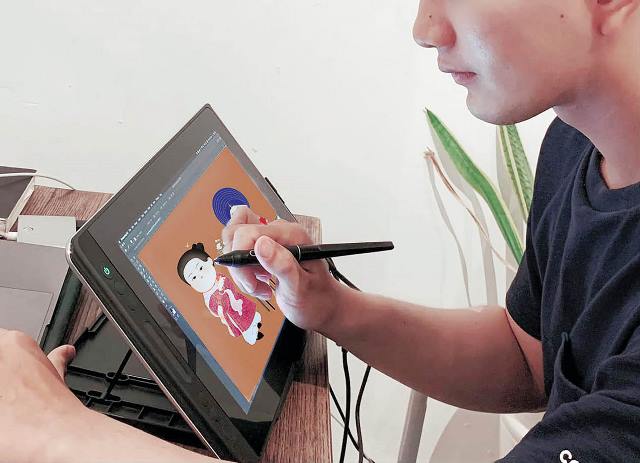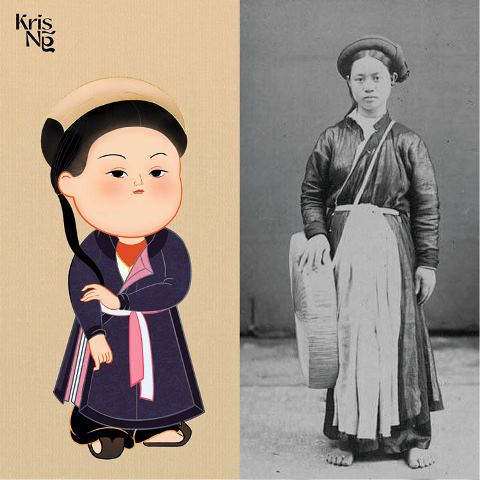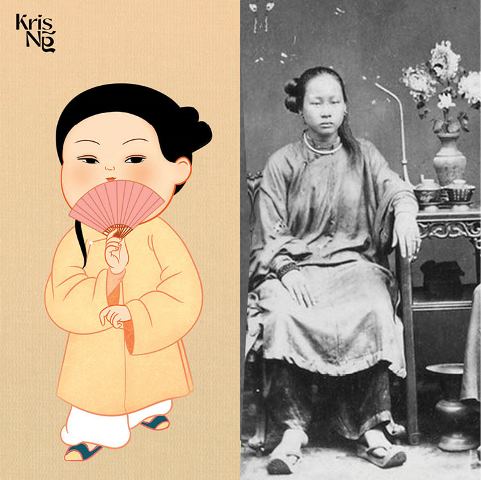
Drawings in Chibi style by Quoc Tri
The project “Costume for Women in the Nguyen Dynasty” consists of 14 drawings portraying the costume of the Nguyen Dynasty accompanied by photos of the original costume. For each drawing, the name, materials and features of the costume are noted.
The drawings in Japanese Chibi style with a computer look cute and familiar. Despite that, they still retain typical features of the costume and portray faces of Asian women. In addition, the details on the costume are meticulously drawn, looking both lovely and sophisticated.
According to Quoc Tri, he chose the Chibi style to generalize the costume in a brief manner so that everyone can easily access without getting bored. To ensure accuracy for the drawings, he skipped just a small number of patterns and focused on shape.
“I draw the costume in the most general manner. Therefore some details and patterns may be inaccurate. However, I still based on the patterns and their arrangement on the original ancient costume,” said Tri.

Five-flip ao dai with narrow sleeves
According to Quoc Tri, the costume of the Nguyen Dynasty was extremely diverse, but few people know it. Most people are familiar with the traditional five-flip ao dai with narrow sleeves, the forerunner of the current ao dai. Every region has variations and different ways of dressing. Through the project, Tri wanted to provide people with an overview of the ancient costumes.
As a project related to culture and history, Quoc Tri must study many prestigious old documents and websites about the ancient costume. He also consulted with friends who were knowledgeable about the ancient costume so that he could bring people accurate information.
“If one doesn’t have good knowledge about the traditional costume, one can make mistakes when designing it. This project required knowledge about the traditional costume, especially its standard and how to dress it,” confided Tri.

Tac ao dai
Interested in Vietnamese culture, Quoc Tri likes learning about ancient costume. With this passion, he co-founded Hoa Nien in Ho Chi Minh City, a organization that sells Vietnamese ancient clothing, especially the costume of the Nguyen Dynasty. Though his idea of the project had appeared a long time ago, not until the COVID-19 epidemic could he find time to implement it.
Graduated in graphic design, Tri has always had a special interest in Asian culture in general. At school, he enjoyed learning about the Japanese and Chinese cultures as well as the Vietnamese folk culture.
Through research, Tri discover that there are many interesting things about Vietnamese culture that few people know about. He always tries to bring the national spirit into his designs, thereby giving people a clearer view of the diverse and colorful Vietnamese culture. That was also the premise for him to research and complete the project of the costume of the Nguyen Dynasty.
“What makes me happy is that through art, I can bring Vietnamese culture closer to people in the most accessible way,” said Tri with excitement.
My drawings are inspired by paintings by Mai Trung Thu and Le Pho, the leading painters in pre-modern painting.
“Quoc Tri’s project is very interesting and useful in providing knowledge about the traditional costume for women, especially to young people,” said Dr. Phan Thanh Hai, Director of the Department of Culture and Sports, with excitement while seeing the drawings on Facebook.
The drawings were also well received by young people. Ton That Minh Khoi, the founder of the webpage "Thien Nam Lich Dai Hau Phi" specializing in research on court rituals and the royal culture also highly valued Quoc Tri's cute and familiar drawings.
“The drawings are really valuable as reference. They were done with clear sources and evidence, helping the public to visualize the costume for women in different areas and of different social classes in the Nguyen Dynasty. Quoc Tri's chibi drawings of the historical theme are accessible to the public, becoming a visual and vivid reference source for those who want to learn about the costume of the Nguyen Dynasty,” said Minh Khoi.
Story and photos: MINH HIEN